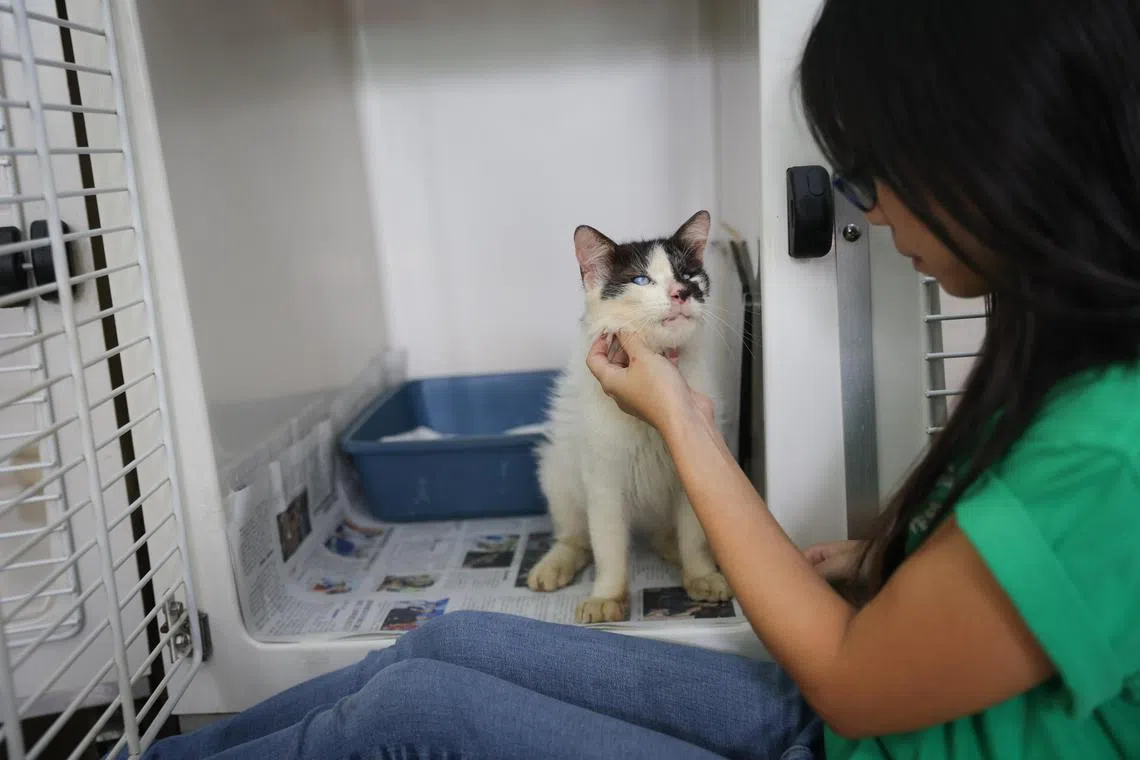Animal shelters see up to 50% fall in pet adoptions as more people return to office
Sign up now: Get ST's newsletters delivered to your inbox

Peaky, a 7½-year-old blind cat, is ready for adoption at SPCA. Pet adoption numbers here have decreased in recent years.
ST PHOTO: ONG WEE JIN
Follow topic:
SINGAPORE – Local animal shelters and welfare organisations have seen up to a 50 per cent fall in adoption numbers in recent years, with some attributing the drop to rising costs of living and more people returning to the office after the Covid-19 pandemic, among other reasons.
Action for Singapore Dogs (ASD) vice-president Wendy Low told The Straits Times that 42 dogs were adopted from ASD’s shelter in the first six months of 2023, fewer than a third of the 148 dogs that were adopted in 2022.
The shelter saw 208 adoptions in 2019, 270 adoptions in 2020, and 239 adoptions in 2021.
“The sharp decrease can be attributed to people returning to work once the Covid-19 threat was over,” said Ms Low.
“Also, we rehomed so many dogs in 2020 and 2021 that we don’t have many adoptable dogs left to rehome. (I’m) not saying that we don’t have many dogs, but that the dogs left can be more challenging, behaviour-wise, and would need more time for us to rehabilitate them.”
Society for the Prevention of Cruelty to Animals (SPCA) executive director Aarthi Sankar said the animal welfare charity, which runs a shelter in Sungei Tengah with more than 150 cats and dogs at any point in time, had 458 of its animals adopted in the first eight months of 2023.
With close to three-quarters of the year over, the figure is slightly more than half of the 836 adoptions it oversaw in 2022. The charity saw 979, 732 and 898 adoptions in 2019, 2020, and 2021, respectively, said Ms Sankar.

SPCA executive director Aarthi Sankar said 458 animals were adopted from the Sungei Tengah shelter in the first eight months of 2023.
ST PHOTO: ONG WEE JIN
“Adoption rates might be dropping because more people are going back to work, which leaves less time for pet care,” said Ms Sankar, adding that this year’s adoption numbers are likely to remain below those of 2022 due to “persistently low” adoption rates.
“Also, higher prices caused by inflation might discourage potential pet owners due to increased costs for things like vet visits, pet food and supplies.”
She added that the charity recorded a 44 per cent rise in animal cruelty cases from 2021 to 2022, as well as an increase in abandonment cases.
Said Ms Sankar: “There were 96 abandoned animals in 2022, and between January and March 2023, there were already 81 abandoned animals.”
While ASD saw an increase in adoptions during the pandemic in 2020 and 2021, some dogs that were adopted before the pandemic were returned to the shelter, said Ms Low. Most had belonged to expatriates who had to relocate due to loss of jobs or high rental prices, she added.
Animal welfare group SOSD Singapore and non-profit organisation Project Luni have also seen a 25 to 50 per cent drop in adoptions over the last three years.
Project Luni founder Nina Astolfi said that aside from the higher cost of living and more people returning to the office, oversaturation in cat ownership due to an increased adoption rate during the pandemic, and a rise in overseas travel after the pandemic could have contributed to the drop in adoptions.
While falling adoption numbers have not had an immediate and direct financial impact on the operations of SOSD and Project Luni, SOSD head of operations Kieran Kua said the population of older dogs that remains in the shelter will likely incur more costs in the future due to their health issues.
She added: “Also, if dogs do not get adopted, they will continue to occupy space at the shelter, and we will be unable to rescue other dogs that may need help.”
Ms Sankar said SPCA also relies primarily on donations to manage its operating costs.
“Adoption fees charged are nominal and help to partially cover some expenses related to sterilisation, microchipping and vaccinations,” said Ms Sankar.
“However, SPCA has been affected by rising costs due to inflation, and we have intensified our fund-raising efforts to help defray some of these costs.”
She added: “When there are fewer animals being adopted, we are limited to being able to accommodate only the most critical, life-threatening cases during rescues as we have a fixed capacity.”


